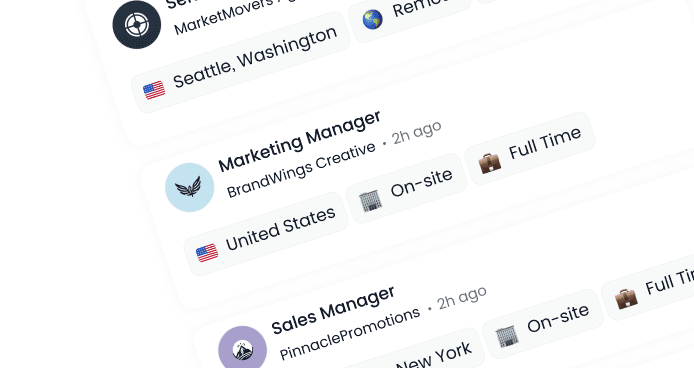A Modern Guide to the Best Recruitment Tools for Employers
Published:
July 5, 2025
All
Recruiting Tips
AI Recruitment
Employer Branding
Hiring just got smarter. Here are the tools you need.
Introduction
Recruitment in today’s age is challenging, and it’s only going to get tougher as competition increases. Sorting through all the applications and picking the right candidate is a time-consuming task and a very laborious one as well. It is no wonder more and more recruiting professionals and businesses are opting for tools to make their jobs easier. In fact, according to Jobscan, over 95% of Fortune, 500 companies now rely on digital recruitment tools, such as ATS (Applicant Tracking Systems), to optimize the hiring of suitable candidates.
It doesn’t matter whether you are an HR manager, talent acquisition specialist, or a business owner; digital tools are becoming a necessity, and new innovative options utilizing AI and multimedia are becoming more common. However, picking one that is best when it comes to aligning with your company’s goals and making your job easier can be hard. This blog explores the best recruitment tools for employers and offers practical insights into various solutions that enhance recruitment efficiency.
To start off, let us look at why there has been such a phenomenal increase in the use of recruitment tools, whether for sourcing or other aspects of the hiring process.
Reasons Behind the Rise of Recruitment Tools
Previously, we briefly discussed why employers would look towards the utilization of digital tools for their hiring and recruitment needs. These claims are supported by research showing that AI can cut hiring time by 50%. Reduction in hiring time is just one of the many benefits that recruitment tools offer when it comes to the hiring process. Below we look at the different steps of the hiring process and the benefits digital systems can provide.
When it comes to the sourcing stage, the right digital tools can automate the job posting process across various recruitment marketing platforms. Through this method, vacancies can be advertised in a manner that allows for greater visibility and a greater potential to attract diverse talent pools. Furthermore, the use of digital systems to automate the screening and assessment process assists recruiters and hiring departments in quickly picking out qualified candidates, reducing time and manual workload, and reducing bias.
When it comes to interviews, softwares can give valuable support assisting both live and asynchronous meetings. Then ATS and CRM systems can simplify candidate management by offering all data in one place and automating the communication process. These tools not only allow recruiters to give a more personalized follow-up but also provide the candidates with a positive experience.
Let us not forget the onboarding phase; that is where AI chatbots can enhance efficiency and provide ease to the candidate. AI chatbots can assist with a candidate’s learning curve by giving immediate responses to candidate queries once an initial onboarding session is done.
Having looked at the benefits of digital tools used during the hiring process, it becomes clear why these miracles of modern technology are becoming highly coveted. Next, let’s look at the various types in depth and some of the top companies that specialize in them.

Types of Tools for Recruitment and Selection
Job Boards
Job boards are online platforms for posting vacancies and attracting candidates. They include niche boards, aggregators, and company career pages. Key features include wide reach, easy candidate filtering, and mobile optimization. They help employers overcome challenges like low visibility and high competition.
An excellent example is DigitalHire, which leverages AI and video job postings to enhance candidate engagement. Did you know research showed that video interviews increase hiring efficiency by 67%? The utilization of video tech allows employers to quickly assess potential recruits.
Testing and Assessment Software
Testing and assessment software evaluates candidate skills and cultural fit. These tools offer online tests, coding challenges, and psychometric evaluations. Their key features are automated scoring, real-time feedback, and customizable assessments. They address common issues such as bias in hiring and unverified candidate skills.
Criteria Corp stands out as a trusted example, providing robust online assessment solutions.
Interviewing Software
Interviewing software streamlines remote and in-person interviews. It offers live video conferencing, asynchronous video interviews, and integrated scheduling. Key features include recording capabilities, interview analytics, and easy collaboration among hiring teams. These tools help reduce scheduling conflicts and speed up the interview process.
HireVue is a prominent example that supports efficient, bias-minimized candidate interviews.
Applicant Tracking Systems (ATS)
An ATS centralizes candidate data and streamlines the hiring workflow. These systems manage resume screening, interview scheduling, and communication tracking. Their key features include workflow automation, reporting dashboards, and integration with other HR tools. They tackle challenges such as disorganized candidate data and time-consuming manual processes.
Greenhouse is widely recognized for its robust applicant tracking capabilities.
CRM Software
CRM software in recruitment manages candidate relationships and nurtures talent pipelines. It features candidate segmentation, automated outreach, and personalized communication tools. These systems help maintain long-term engagement and build a strong talent community. They overcome challenges like ineffective follow-ups and candidate drop-off.
HubSpot is a reliable CRM solution known for its comprehensive candidate relationship management.
Onboarding Tools
Onboarding tools help integrate new hires quickly and smoothly. They offer digital document management, training modules, and employee self-service portals. Their key features include automated task assignments, personalized onboarding schedules, and progress tracking. These tools address the challenge of ensuring consistent and engaging onboarding experiences.
Rippling is a leading example that supports effective employee onboarding.
AI Chatbots
AI chatbots serve as virtual assistants in the recruitment process. They handle candidate inquiries, screen applications, and provide real-time updates. Their key features include 24/7 availability, natural language processing, and integration with recruitment systems. They help resolve challenges such as delayed responses and increased administrative workload.
Mya is a top example of an AI chatbot that enhances candidate engagement and streamlines communication.
In Conclusion
As we reach the end, we would like to conclude by saying that the hiring landscape is ever-evolving as new and innovative methods are being created. Employers can benefit greatly from state-of-the-art recruitment tools that enable organizations to streamline and optimize their hiring processes.
That is where DigitalHire’s innovative video job board is a prime example of how advanced technology can redefine recruitment. It offers automated, efficient, and engaging solutions to modern hiring challenges. The future of recruitment is digital, and the right tools can provide a significant competitive edge.
So, are you ready to transform your hiring process? Get a free trial by setting up a free job post at DigitalHire—check out the advanced automation features and witness the difference.
FREE JOB POST
Looking to fill a position quickly? Post your job for free and reach top talent today!




